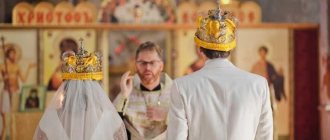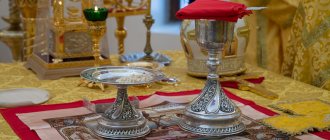By entering a monastery, a person renounces everything worldly and takes vows of virginity, obedience and non-covetousness. But it also happens that a monk cannot or does not want to keep these vows any longer and wants to leave the monastery.
Monastery abbots cannot prevent such a desire. But they are obliged to try to persuade those who want to become a layman to stay and not renounce their vows. But what happens if the monk cannot be dissuaded?
I have permission
Archimandrite Tikhon (Shevkunov) in his article “The Irreversibility of Monastic Vows” states that until 1823 the Russian Church was guided by the universal Orthodox canonical act, which declared a person who accepted monasticism to be once and for all dead to worldly life.
However, in April of that year, the abbot of one of the monasteries of the Ekaterinoslav diocese, Joasaph (Levedinsky), turned to the Holy Synod with a request to allow him to leave the monastic order, return to worldly life and get married.
This was followed by fierce disputes in the highest church authority, which ended with the adoption of the “Law on the abolition of monasticism,” listed in the “Complete Collection of Laws of the Russian Empire” under number 29413.
Re-recognized as legitimate on October 26, 1832, this bill was finally enshrined in Article 86 of the Spiritual Consistory, although it did not correspond to any canonical or theological justification of the Eastern Orthodox Church.
Trying to understand this strange situation, the Greek Meletius Apostolopoulous in his work “Ecclesiastical Law of the Eastern Orthodox Church” left the following conclusion for readers: “We turned to the best canonists of Russia with a request to explain how this practice of the Russian Church is compatible with the fundamental teachings of the Eastern Church on this question. It appears from the replies received that they are unable to provide any reasonable justification for this practice.”
Procedure for breaking a vow
Before beginning the procedure of removing the vow from a monk who wished to leave the walls of the monastery, all members of the spiritual brotherhood had to make every effort to convince him to stay.
This responsibility was first assigned to the abbot; if his arguments were not successful, then a cleric appointed by the bishop was involved in the matter, and then the entire episcopal council.
Representatives of the clergy were given six months to convince the monk; if during this time their persuasive conversations did not contribute to changing the disastrous decision, then, according to paragraphs 446-450 and 500-501 of the first part of the “Rule”, he could deviate from his vows.
In order to voluntarily return to the life of a layman, a monk had to undergo the procedure of defrocking, which was simply called defrocking, and a monk - defrocking.
To do this, in the church or in the diocesan administration, before the defrocking, the text of the decree on depriving him of the clergy was read out, after which, under the general exclamations of “Anaxios!”, which is translated from Greek as “Unworthy!”, those corresponding to his rank began to remove the monastic robe from him: kamilavka, kukol, klobuk, skufyu, cassock, cassock.
This ritual, however, in relation to monks who violated the monastic rules, was also spoken of by the Monk John Cassian the Roman, who described that in the monasteries of the Monk Pachomius “if they notice that he [the monk] has the vice of some kind of grumbling or evil disobedience, then having thrown off his monastic clothes and put on secular clothes, they drive him out of the monastery.”
The monastic robe of a person who left the service of God was immediately burned after his departure along with other church equipment that had expired.
Having deprived the apostate of the right to wear monastic robes, they cut off a tuft of hair from his head and beard, gave him a secular dress, forbade him to wear the name assigned at the time of tonsure, took away the “character issued upon entering the monastery,” and then the disrobed monk was driven out of the temple with a rod.
If the monk was in the priesthood, then by decision of either the diocesan bishop or the church court he was deprived of his rank and the right to perform divine services.
Nowadays, there has been only one change in this procedure: an apostate who has renounced monasticism no longer has his hair cut off, but, as before, his funeral service is performed exclusively according to the secular rite.
Achilles
Views: 4,652
This reflection text can be considered an answer to our reader’s question “Why can’t you marry a hieromonk?” .
***
Many new monks are very delusional about themselves and greatly overestimate their capabilities. Yes, it’s good to visit a monastery for some short period of time and, having received spiritual and aesthetic pleasure from the shrines located there and from the amazing beauty and splendor of the monastic worship, plunge into a completely different monastic life in its ancient way, and then return again to everyday life.
However, recently, unfortunately, among some confessors - who are generally called to help a person develop on the spiritual path - the shameful practice of forcing people to accept monasticism has spread. These confessors parasitize on the trust of the majority of believers in such a divinely inspired phenomenon as eldership. And it’s rare that any of the extremely gullible and naive converts, who treat everything spiritual with sacred trepidation, can discern a wolf in sheep’s clothing in some “gracious old man.” When a person comes to faith in God, a special state of mind so embraces him that he does not allow even a shadow of doubt in his thoughts that he can be deceived by the “servants of the Ineffable Light.”
These “divinely inspired elders” and their entourage, with the connivance of representatives of the highest church authorities, resort to completely sectarian methods: for example, they keep silent about the inadmissibility of marriage after taking the rank of deacon or force them to take monastic tonsure at an early youthful age (although such according to church canons prohibited, especially during the neophyte period), and often even intimidating with “God’s punishment” for disobedience to “God’s will.” And they pursue, taking advantage of the new converts’ ignorance of church-canonical issues, completely selfish goals: obtaining free labor for their monasteries, the possibility of rapid career growth from an increase in the number of inhabitants, and creating a special “grand” atmosphere around their “spirit-bearing elder.” And they are not at all affected by life’s tragedies and broken destinies, which in such cases, unfortunately, is almost inevitable. Not to mention the sophisticated bullying in some monasteries by the authorities under the pretext of saving your soul.
Then you will certainly face another series of disappointments in your spiritual career: despite all your efforts, the majority of the laity perceives you only as a performer of “magical rituals”; the majority of “brothers in the spiritual workshop” see in you not so much a comrade-in-arms, but a competitor “in the market of religious services”; and your hierarchy requires from you, first of all, that you submit reports on time and pay your dues in good faith.
Then you gradually begin to be overcome by a feeling of loneliness and finally come to rethink your life values and attitude towards family life. You realize that the real joy in her comes not from the opportunity to live for your own pleasure (in this case, this would be a manifestation of selfishness) and the availability of intimate intimacy with the opposite sex (according to church canons, such intimacy is permissible only in a married marriage), but from the possibility of communication with a person dear to your heart, with whom you share all the hardships and joys of a common life feat. And first of all, the joy of mutual selfless affection for each other and joint raising of children - as the quintessence of human life and the fruit of mutual parental love, as well as the fulfillment of the life duty invested by the Creator in human nature.
It is probably difficult to imagine a feeling more reverent than that which a father may experience at that moment when, not having had time to cross the threshold of the house, he catches the enthusiastic childish gaze of his son or daughter running into his arms, feels the touch of a tender child’s cheek and realizes that besides him, for his child there is no one more dear and beloved in the world?
You come to the realization that a virtuous and pious life in the world is no less worthy of admiration and reward from the Creator than life in a “spiritual oasis” outside the monastery fence. All people are called to a righteous life, to holiness and to keep the commandments of God - not only monastics, but also lay people. The difference between them lies not in the degree of holiness, but in the manner of service, each of which requires a special calling, and in special gifts from God on the chosen path of life.
Many people (especially in adolescence) who have not received proper church education are unable to distinguish the desire to live an ordinary church life from a monastic one, and at the beginning of their spiritual growth they may well make a mistake (especially under the influence of neophyte maximalism) in choosing a path in life, easily mistaking the desire to live a full-blooded spiritual life for a desire for monasticism, which sometimes, as already indicated above, is used by unscrupulous (to put it mildly!) confessors.
In order to make it more clear what we are talking about, you can resort to the language of images. If the Church, that is, believers, is represented as an army, then the clergy can be compared to officers, and monastic monasteries can be likened to guards units. And if you decide to join the ranks of the “church guards,” despite all the difficulties awaiting you along the way, then in our age, unfortunately, full of meanness and cynicism, you need to be very careful so as not to end up in the “spiritual penal battalion.”
If you make a mistake in choosing your life path, you can pay bitterly. The state of mental emptiness on the verge of a nervous breakdown may not last a year or two. And you don’t know whether you will ever get out of it or not, and no one can give you any guarantees. Year after year passes, and the feeling of self-unrealization grips you more and more. Loss of appetite and sleep; and nothing brings you joy anymore, although if you want you can allow yourself almost any pleasure. You also cannot find consolation in wine - as luck would have it, there is no craving for it, and it does not cheer you up at all, only making you more melancholy. You try to drown out all this, loading yourself up to exhaustion with work, communicating with people, documents, books - anything, just not to be alone with your experiences and thoughts. However, nothing brings any consolation...
The only joy in such a state is the opportunity to communicate with children, but after that you are inevitably overcome by a feeling of despondency, or even despair - from the absence of children’s laughter, crying, babbling, smell (there is probably nothing more pleasant in the world), and especially if You got used to them from early childhood, growing up in a large family.
Refuse holy orders? But only in him do you feel your calling, like the calling, for example, of an artist who cannot help but paint his paintings, or a composer who cannot imagine his existence without music. But even church services - christenings, weddings, meetings with children in kindergartens and schools - everything cuts to the quick, your heart contracts with melancholy and hopelessness, and you are involuntarily forced to hide your eyes from those around you with tears treacherously welling up in them...
And the problem here for many is not a simple attraction to the opposite sex, or, at least, not at all in its vulgar manifestation, but in the need for mutual feelings reaching the limit of mental capabilities, in the irresistible desire to show tenderness, care, your best and noble qualities in relation to the one who can reciprocate your feelings, and with whom you can share the joyful burden of giving birth to children and the caring chores of raising them.
And sooner or later she comes across your path in life...
Not everyone can withstand such a test (and this is the hardest test for both). The church canonical norms regulating the life of the Church (compiled, moreover, in ancient times), unfortunately, do not consider this situation, and those who have fallen under the influence of false spiritualists have to find a different way out of it. Some, gritting their teeth, try with all their might to remain faithful to the vows they inadvertently made. Others, renouncing their rank, return to ordinary worldly life. Still others, in the event of a lenient attitude from the ruling bishop (usually due to special life circumstances, as well as due to the sensitivity of the situation and the doubtfulness from the church-canonical point of view of the legality of this kind of tonsure), decide to enter into a civil marriage, continuing their service in the Church .
I even know of a couple of cases where bishops who were living in a “civil” marriage transferred hieromonks to the category of white clergy. However, such episcopal “liberties” in the church environment are considered anti-canonical, and certainly one of the next bishops in the department may have the full weight of church legislation brought down on the former monk who has become a Balti, according to which he should be deprived of the priestly rank. But at the same time, the monastic rank is not removed, and church rules instruct him (already as a simple monk), leaving his family (naturally, alimony is silent), to go to live in one of the monasteries in order to spend the rest of his life in repentance.
In this case, a completely paradoxical situation arises. The priesthood, being a sacrament, in the Eastern Christian (as opposed to the Western) tradition is considered “washed away” - those deprived of the priesthood no longer have the right to hope for its restoration. Monasticism, on the contrary, is not considered a sacrament in the church tradition, but is declared lifelong and “indelible.”
In modern church practice, it is customary to condemn monastic clergy who have left their ministry and returned to worldly life. If someone decides to make their relationship public and have their issue resolved in a church court, then they are subject not only to severe reprimand (church disciplinary punishment), but also (if they do not want to leave their family and live in some remote monastery for repentance) completely thrown out of church life.
Although the pre-revolutionary practice (declared by the majority of current canonists to be unlawful), starting from the times of Peter the Great, was completely different - a person who voluntarily (but there were cases of forced removal) relinquished his monastic rank was allowed to enter into marriage, which was performed in accordance with the spirit of that time through the sacrament weddings And the Spiritual Regulations, despite the restrictions on place of residence and public service imposed on defrocked people, ordered that they be given the opportunity to get into church (as lay servants) or military service.
At the present time, usually those who decide to break with their priestly past are deprived of not only spiritual, but also basic material support. The majority of the monastic brethren - with the exception of high-ranking and “our own” - have neither work records nor contributions to the Pension Fund (that is, they cannot count on a normal pension), and have no right to hope (despite many years of selfless service in holy orders) for help from the mother Church.
We may have different attitudes towards Roman Catholics and argue with them about the degree of purity of faith, but regarding the issue under discussion, one cannot but admire the attitude of the current pontiff towards the clergy who left ministry to start a family. He not only seeks communication with them, but also shows them his support: “If a priest falls in love,” he said, “this leads to a revision of his vocation and a change in life. He must find the bishop and tell him he loves him and leave the priesthood. And then what? “And I’ll help him find something to do.”
From the lips of Pope Francis, words of reproach, but pastoral encouragement, are addressed to former priests:
“If you make a mistake, get up! There is nothing more human than mistakes."
“Each person should look down on another person only when he needs help up.”
“No person can be condemned forever for having stumbled; There is no hatred that cannot be overcome by love!”
“Correcting a brother is a ministry, and it becomes possible and effective only when everyone recognizes himself as a sinner and in need of the Lord’s forgiveness. Conscience itself, which helps me forgive the mistake of another, reminds me even earlier that I myself have made mistakes and have made mistakes many times.”
“Only God alone is devoid of weakness, but man inherently needs God’s support. We cannot throw anyone away because we are all treasures in the eyes of God. Please remember to pray for me too, because I am weak too.”
“The Church is not an organization, neither cultural, nor social, nor even religious... The Church is the family of Jesus.”
According to the Roman Pontiff, the Church is called to “heal deep wounds with sincere dialogue” and to “wash feet, not brainwash.”
And if we are to apply punishments against “stumbled” priests within the framework of existing canonical norms, then, logically, it is necessary to start first of all with those who - in fact, fraudulently - ordained and tonsured them in violation of these same canonical norms. And together with their victims, they will be expelled from the priesthood and sent to repentance in provincial monasteries.
If our hierarchy does not have the will and determination to take equally fair actions in relation to both, then it is necessary to at least change their attitude. By abandoning hypocrisy, put a barrier to further abuses on the part of intra-church sectarians and very zealous church functionaries. And to show “mercy to the fallen”, who find themselves (even not so much through their own fault as through the fault of unscrupulous shepherds) in a difficult life situation, but, despite this, are not embittered and continue to remain faithful children of the mother Church and expect from her in the person their spiritual mentors and leaders, not disgust and cruel treatment towards themselves, but if not compassion, then at least human sympathy and spiritual support.
If you like our work, support us:
Sberbank card: 4276 1600 2495 4340
Via PayPal
Or using this form, entering any amount:
Worldly life
Having received a certificate of residence in the monastery, the former monk could socialize in worldly life, although in the Russian Empire the attitude towards defrocked people was very biased, to the point of infringing on their civil rights for a long time.
According to data cited by historian Leonid Belovinsky, the former monk, having returned to secular society, was restored to his former class, but was deprived of all ranks.
If a defrocked man was a deacon or priest, the path to public service was closed to him for 10 years, and he could only be taken into the army as a private.
For monks, there was a 7-year ban on living in the capital, as well as within the province where his former monastery was located. In addition, during this period he was not accepted into the civil service and could not marry.
As for weddings, in other words, church marriages, defrocking was not allowed, since it was believed that a mortal bishop was unable to free an individual from his voluntary vow of celibacy given to God when he was a monk.
Since leaving the monastery is equated to a canonical crime, the person who took this step was “sentenced” to excommunication from Holy Communion for a time determined by the head of the diocese separately in each specific case.
In the old days, failure to comply with prohibitions was punishable by deportation to Siberian settlements.
How did the monastic rite of renunciation take place?
Each person entering a monastery first took monastic vows and renounced worldly life. Afterwards he took monastic vows of virginity, obedience and non-covetousness. And anyone who wanted to leave monasticism had to renounce his vows and tonsure. Of course, the monk who decided to take such a step had to first inform the abbot of the monastery. He had no right to simply leave the monastery and announce his decision after the fact.
Before the monk received permission to leave monasticism, the abbot and all members of the monastery tried to dissuade his brother from committing this act. First, the abbot spoke to the monk, and then a cleric appointed by the bishop. If they didn’t succeed, then the bishop’s council got involved. Six months were given for persuasion. And if the monk who wanted to leave did not heed the admonitions during this period, then he was given permission to deviate from his vows.
The procedure for defrocking was called defrocking, and the monk who passed it, accordingly, became defrocked. At the diocesan administration or in the local church, a decree on deprivation of clergy was read to him. And then everyone present exclaimed “Anaxios!” This word was translated from Greek as “unworthy.” Then his monastic robe, corresponding to his status, was removed from his monastic robe. All of his monastic attire, along with church equipment that had served its purpose, was burned. It is interesting that the same ritual was performed on those who abandoned their vows. That is, if a monk, for example, secretly married or violated the monastic rules in another way, then he was expelled from the monastery, having first taken off his robe - cassock, cassock, skufia or kamilavka.
If a monk had holy orders, then he was deprived of the right to perform divine services and rank. At the conclusion of the ceremony of breaking the vows, a piece of hair from the apostate’s beard and head was cut off and he was given secular clothes and a certificate of stay in the monastery. In our time, the ritual of leaving monasticism is exactly the same, with one exception. Today, those leaving monasteries do not have a tuft of hair cut off from their heads and beards. Once in the world, the former monk is free to do whatever he wants.
Return to the monastery
If the former monk, realizing the error of his actions, expressed a desire to return to the monastery, he was reinstated in it in the manner prescribed for those who, by decision of the Hierarchy, were expelled from the monastery.
Usually, after bringing repentance, the defrocked man went to serve God in the same brethren that he had previously left, but if by that time it was closed, he was transferred to another.
Having successfully completed the probationary period, he was allowed to be called by his former church name and wear monastic clothes.











